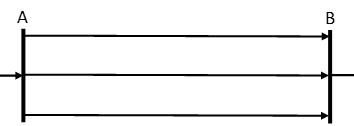Difference between revisions of "EMO:SFT Overview"
Jump to navigation
Jump to search
| Line 1: | Line 1: | ||
| − | |||
[[File:SFT simple example.png|right]] | [[File:SFT simple example.png|right]] | ||
| − | + | The principle behind SFT is simple: if one circuit in the grid has an unplanned outage, then every other line in the grid could then become overloaded. Therefore we need to limit the flow on some circuits just in case there is an outage. For example, the figure shows a portion of a grid where three identical circuits are in parallel, so the total power flow is divided equally across the three. If one circuit trips, then the other two will each end up carrying 50% more power than they did prior to the trip. | |
| − | If one circuit trips, then the other two will each end up carrying 50% more power than they did prior to the trip. | ||
Revision as of 13:18, 12 February 2014
The principle behind SFT is simple: if one circuit in the grid has an unplanned outage, then every other line in the grid could then become overloaded. Therefore we need to limit the flow on some circuits just in case there is an outage. For example, the figure shows a portion of a grid where three identical circuits are in parallel, so the total power flow is divided equally across the three. If one circuit trips, then the other two will each end up carrying 50% more power than they did prior to the trip.
